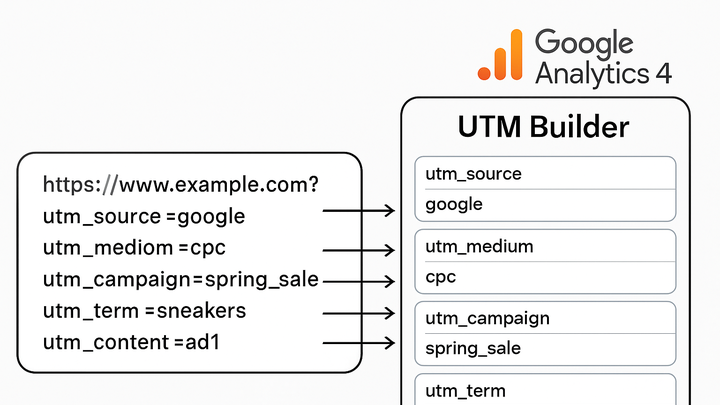Published on 2025-06-22T10:11:22Z
What is a UTM Builder? Examples and Usage
A UTM Builder is a specialized tool used in digital analytics to streamline the creation, standardization, and management of UTM-tagged URLs. By guiding users through input fields for utm_source, utm_medium, utm_campaign, utm_term, and utm_content, it eliminates manual errors and enforces consistent naming conventions. These branded links feed into analytics platforms like Google Analytics 4 (GA4) and PlainSignal, enabling robust attribution across channels. A well-designed builder supports batch generation, template reuse, and integration via API or UI. In privacy-focused setups like PlainSignal’s cookie-free analytics, the same UTM parameters are captured without relying on third-party cookies, ensuring accurate campaign measurement even under strict privacy regulations. Whether you run paid ads, email blasts, or social media outreach, a UTM builder saves time and delivers clean, actionable data.
Utm builder
Tool to generate and manage UTM parameters for tracking campaigns in analytics platforms like GA4 and PlainSignal.
Why Use a UTM Builder?
Creating campaign URLs manually is error-prone and time-consuming. A UTM builder streamlines this process by providing a guided interface to populate tracking parameters systematically. It ensures consistency, reduces typos, and centralizes URL management.
-
Consistency in naming
A UTM builder enforces standardized naming conventions across campaigns so that data in analytics platforms like GA4 and PlainSignal is uniform and comparable.
-
Avoid typos
Predefined options minimize manual entry errors that lead to fragmented reports.
-
Standardized reporting
Consistent parameters ensure clean data segments for accurate analysis.
-
-
Efficiency at scale
Generate multiple campaign URLs in seconds, saving time on repetitive tasks and allowing for rapid A/B testing or multi-channel outreach.
-
Batch url generation
Build dozens or hundreds of links with a single CSV upload or API call.
-
Predefined templates
Reuse saved templates for recurring campaigns to reduce setup time.
-
How a UTM Builder Works
At its core, a UTM builder gathers campaign metadata and appends it to your base URL as query parameters. Users fill in fields for each UTM tag, and the tool outputs a ready-to-share link.
-
Parameter fields
Fill in the five standard UTM parameters that tracking systems recognize.
-
Utm_source
Identifies where the traffic originates (e.g., newsletter, google, facebook).
-
Utm_medium
Specifies the marketing medium (e.g., email, cpc, social).
-
Utm_campaign
Names the specific campaign (e.g., spring_sale, product_launch).
-
Utm_term
Optional: Records paid search keywords for granular ad tracking.
-
Utm_content
Optional: Differentiates similar content or links within the same ad (e.g., button_vs_text_link).
-
-
Url output
Once parameters are set, the builder concatenates them to the base URL in the correct query string format (e.g.,
?utm_source=...&utm_medium=...).
Integrating with GA4 and PlainSignal
After generating UTM-tagged URLs, these links feed campaign attribution data into analytics platforms. Here’s how they work with GA4 and PlainSignal.
-
Google analytics 4
GA4 automatically detects standard UTM parameters in incoming URLs and attributes sessions accordingly. You can review campaign performance under Reports > Acquisition > Traffic acquisition.
-
Traffic acquisition report
Shows sessions segmented by campaign, source, and medium fields.
-
Auto-tagging vs manual tagging
While GA4 supports Google Ads auto-tagging, UTM parameters are necessary for other channels.
-
-
PlainSignal (cookie-free simple analytics)
PlainSignal captures UTM parameters without relying on cookies, ensuring privacy-friendly attribution.
-
Initialization code example
<link rel="preconnect" href="//eu.plainsignal.com/" crossorigin /> <script defer data-do="yourwebsitedomain.com" data-id="0GQV1xmtzQQ" data-api="//eu.plainsignal.com" src="//cdn.plainsignal.com/plainsignal-min.js"></script>
-
Best Practices for UTM Tagging
Maintain clean, reliable, and actionable campaign data by following these recommended practices when building UTM URLs.
-
Use clear naming conventions
Create a naming taxonomy that your team sticks to, including project name, date, or content type to make analysis intuitive.
-
Lowercase and hyphens
Use lowercase letters and hyphens instead of spaces to avoid duplicate parameter values.
-
-
Document campaign parameters
Keep a shared spreadsheet or CMS entry that records every active and historical UTM combination to prevent overlap.
